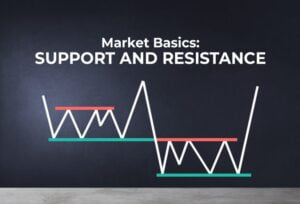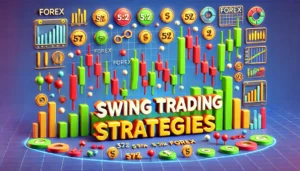
Are you a trader who gets stressed by constantly watching price charts? Or do you wish to trade but have limited available time? If you answered yes, swing trading might be the right option for you.
In this article, we have explained what is swing trading, how it differs from day trading & scalping, and 3 top swing trading strategies to stay on top of the markets.
Table of Contents
ToggleWhat is swing trading?
Swing trading refers to a trading style where traders hold positions for a couple of days to several weeks. The time scale may also extend to some months, and yet some label them as swing trades.
In swing trading, market players seek to capture one price “swing” or “move” on larger time frames. They primarily rely on technical analysis to identify medium-term trade opportunities, acquiring stable gains over the long run.
Swing trading vs. day trading vs. scalping
Contrary to swing trading, day trading involves short-term trades that are favorably closed before the end of a trading day, whereas scalping is one step more extreme, where trades are opened & closed within minutes. To further understand the differences between these 3 types of trading methods, it is better to look at the following chart.
| Scalping | Day trading | Swing trading | |
| Holding duration of the trade | From some seconds to minutes | Few hours – no overnight position | From weeks to two months |
| Level of required attention | Constant & great attention | High attention, frequent screen checks | Low attention, 15-20 minutes screen check daily |
| Frequency of trades | High | Intermediate | Low |
| Psychological pressure | High mental pressure | Significantly high stress | Low stress |
3 best swing trading strategies
Here is a list of three time-tested swing trading strategies you can consider for profitable trading.
1. Catch the trend – Most basic swing trading strategy
“Catch the trend or wave” holds a top place among the best swing trading strategies as it is the foundation of this swing trading. This method involves capturing one prominent price swing from an ongoing or emerging trend.
Let’s see what exactly you have to do in this swing trading strategy:
- First, you must identify the dominant price trend by watching the respective chart on a large timeframe, preferably 1D or 1W.
- Next, you have to apply two exponential moving averages, 21 EMA & 50 EMA, on the 1D chart.
- Afterward, wait for the price to respect the present trend and enter a trade when the candle gets rejected from one of the two applied EMAs.
- Set your stop loss just below (bullish trend) or above (bearish trend) the 50 EMA and take profits at the next apparent swing.
We have illustrated this trend swing trading strategy in the GBP/USD chart below. We recognized an emerging downward trend on a one-day chart and applied 21 and 50 exponential moving averages. On a price pull back to the 21 EMA, we placed a bearish trade with a profit target at the first swing low, whereas stop loss was set just above the 50 EMA. Note that traders can also utilize a trailing stop loss to play safe further.
2. Trade in the box – Range trading strategy
Trade-in-the-box is a swing trading technique that focuses on catching the price moves within a ranging market. This strategy becomes relevant when the price is bouncing between “support” and “resistance,” offering multiple ‘buy’ & ‘sell’ trade opportunities.
Here’s what you need to do in this strategy:
- You first have to look for a ranging market on a 4-H or 1-D price chart.
- Mark the supply & demand areas and wait for the price to be rejected from either support or resistance.
- If you identify that price is respecting the specified level, enter a trade on the next candle opening.
- Set your stop loss a little above (in case of sell trade) or below (in case of buy trade) the entry point and grab profits well before the next extreme.
This method stands among the best swing trading strategies due to its simple design and high-profitability chances. The below XAU/USD chart displays this ranging market set-up where the entry point is at the resistance belt. The market is exhibiting two support zones; hence the earlier support is considered TP1 to ensure safe trading. In this system, a suitable stop-loss position would be a little above the shaded resistance level.
3. Ride the reversal – Reversal swing trading strategy
Ride the reversal is one of the most lucrative swing trading strategies as it involves catching a price move from the very start. This strategy is based on the price action reversal set-ups that provide exceptional swing trading opportunities.
Here’s how this strategy works:
- Identify a reversal price pattern, such as head & shoulders or double/triple tops and bottom, on a large timeframe chart.
- On spotting the formation, place the relevant buy or sell trade when all the respective conditions are fulfilled.
- Secure the profits on the first apparent resistance or support and set the stop loss in close proximity to the entry spot.
Similar to day trading and scalping, price action also holds full relevance in swing trading strategies. In the XAU/USD one-day chart below, we have illustrated a “double bottom” price action formation. When the price was clearly rejected from the second bottom, we entered a bullish trade. TP was placed at the next evident resistance while we placed the stop loss just below the bottom area.
Closing thoughts
We have mentioned some reliable swing trading strategies in this write-up; however, note that trading is an inherently risky domain where you cannot always emerge profitable. To increase your overall win ratio, you must focus on trade management and optimize the trade entry/exit points according to the ever-changing market dynamics. Moreover, you should experiment with different strategies on numerous assets or currency pairs and choose a system most suited to your trading approach. Without question, besides the fundamental skills & expertise, trading also requires commitment, patience, practice, and consistency if you want to achieve optimal results.
Read more:
http://thetradingbay.com/scalping-trading-3-best-scalping-trading-strategy/
http://thetradingbay.com/what-is-moving-average-top-4-moving-average-methods-for-successful-trading/













